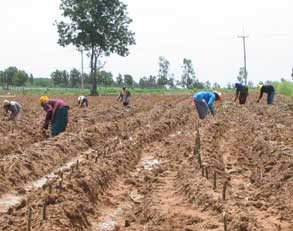The Introduction To Tapioca Starch
|
|
In nature, starch is available in an abundant quantity as a naturally occurring organic carbohydrate. It is found in their roots, stems, seeds of fruits in all forms of green leafed plants. Starch serves the plants as food for energy during dormancy and germination. It is also the most important source of energy for animals and human beings. Starch plays a vital role in our life. Statistics shows nowadays that starch has more than four thousand applications.
|
|
The main commercially-available native starches in use include Tapioca starch, Potato starch, Corn Starch and Wheat starch. From the comparison of these starches, we know that the composition and properties of Tapioca starch is closer to Potato starch and much better than Corn starch and Wheat starch. Nevertheless, in terms of price, Potato starch is much higher than Tapioca starch. With attractive advantages in terms of properties and cost, there is apparently growing demand for Tapioca starch everywhere in the world. Simultaneously, the trend towards healthier lifestyles inspires increasing focus on GMO-FREE Foods.
"GMO-Free" Food Ingredients
Corn starch is recognized as high-GMO ingredient and Potato starch is treated having partial GMO content. Hence, more Tapioca starch will be chosen by food processors instead of Potato starch and Corn starch because our Tapioca starch is GMO-free.
Applications Of Tapioca Starch In Food And Non-Food Industries
Tapioca starches are widely used by following industries:
|
FILLER BINDER STABILIZER TEXTILE |
THICKENER PAPER AS BINDER FOR INDUSTRIAL USES OTHER INDUSTRIAL USES |
Advanced Technology
The processing diagram of Tapioca starch as follows:

With higher starch contents of over 30% and higher yield in production from the rich local soil, fresh cassava root are directly harvested by local farmers and cassavas, as raw material, which have to go through two samplings to detect their starch contents before going to the production line.
The major processing facilities are imported from Europe and Thailand. With these state-of-the-art equipment and experienced specialists, the production process is precisely and strictly controlled and checked to provide customers with the most preferred starch.

 Tapioca starch packed in 50kg bags
Tapioca starch packed in 50kg bags
